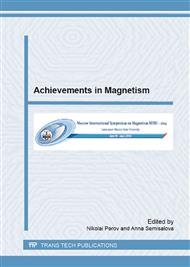p.443
p.447
p.451
p.456
p.463
p.467
p.471
p.476
p.480
Bias Current Effect on Second Harmonic in Asymmetric Magnetoimpedance Response in Amorphous Microwires
Abstract:
The influence of bias current on the second harmonic in the nonlinear magnetoimpedance in an amorphous microwire with a helical anisotropy is studied theoretically. The voltage response of the microwire is found in the framework of a rotational model. It is shown that the application of the bias current leads to the asymmetry in the field dependence of second harmonic. The second harmonic amplitude is analyzed as a function of the external field, current amplitude and the value of the bias current. The conditions of maximum field sensitivity of the second harmonic are found.
Info:
Periodical:
Pages:
463-466
Citation:
Online since:
July 2015
Authors:
Price:
Сopyright:
© 2015 Trans Tech Publications Ltd. All Rights Reserved
Share:
Citation:


